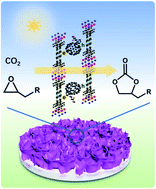Charge separation in hybrid metal–organic framework films for enhanced catalytic CO2 conversion†
Abstract
CO2 conversion has attracted widespread attention because CO2 is a major issue in global warming. In this work, a hybrid metal–organic framework (MOF) film was successfully prepared by embedding PC61BM ([6,6]-phenyl C61 butyric acid methyl ester) into a CuTCPP (TCPP: meso-tetra(4-carboxyphenyl)porphine) film through a solid conversion process. The as-prepared PC61BM/CuTCPP film exhibits a three-dimensional architecture composed of two-dimensional MOF nanosheets, having not only sufficient paths for mass transfer but also active sites exposed directly to substrates. The charge migration and separation in the heterojunction between PC61BM and CuTCPP under light irradiation can dramatically improve the CO2 conversion performance of the hybrid film. The CO2 conversion proceeds rapidly even at room temperature and 1 atm with the PC61BM@CuTCPP film as the catalyst, representing one of the best photocatalysis efficacies so far among MOF-based catalysts, with the conversion up to 92.4% and a turn-over-frequency of 36.0 h−1. This work provides an insight into designing high-performance MOF-based catalysts for CO2 conversion.



 Please wait while we load your content...
Please wait while we load your content...